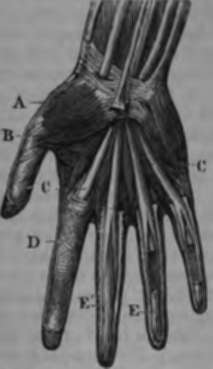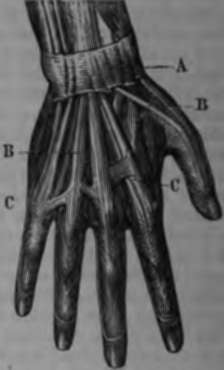The Wrist Joint
Description
This section is from the book "Wonders Of The Human Body", by Auguste Le Pileur. Also available from Amazon: Wonders of the Human Body.
The Wrist Joint
The Wrist-Joint , which unites the hand to the fore-arm, resembles in its mechanism that of the shoulder. Eight bones of different and very complicated forms constitute the wrist or carpus. Three of these form the articulation with the fore-arm, the others are united to the five bones of the metacarpus, the palm, or middle part of the hand, to which the fingers are attached. These are composed of two phalanges in the thumb, three in the index, middle, ring, and little fingers. The first three bones of the carpus are grouped in such a manner as to present an ellipsoid surface on the side of the fore-arm; a condyle which is received by the elliptic cavity formed by the inferior extremity of the radius and ulna. The hemispheric head of the humerus turns on its axis in the glenoid cavity, but this movement is prevented in the hand by the elongated form of the condyle of the carpus. The rotation of the ulna supplies this want, and the hand turns with the bones which are attached to it in supination and pronation. Further, it has a separate movement in flexing the hand forward, backward, or sidewise. In circumduction it describes a cone, and makes many other movements in common or singly.

Fig. 15. The hand, palmar aspect.
A. Short abductor muscle of the thumb, above and outside of which is seen the opposing muscle opponens pollicis).
B. Short flexor of thumb.
CC. Tendons of the superficial flexor of the fingers. D. Sheath of the tendons. E E. Tendons of the deep flexor.

Fig. 16. The hand, dorsal aspect. A. Annular ligament of the wrist. B B. Tendons of the common extensor of the fingers. C C. Tendinous expansions fastening the tendons together.
The numerous muscles which determine these movements form a very complicated mechanism. Their tendons are interlaced and bound together by bands and aponeurotic fibres, and from this results a more or less complete unity of action. It is sometimes difficult to make a movement with a single finger without the others taking part in it, as in executing instrumental music, for instance; but practice gives to these movements perfect independence. The mechanism of the movements of the hand has been made singularly clear by the recent experiments of M. Duchenne of Boulogne, who has succeeded in distinguishing by means of electricity, the action not only of different orders of muscles, but also of each particular one. Gerdy counts thirty-four distinct movements of the hand, and if we include the combinations of these different movements we shall reach a much higher number. The opposition of the thumb to the other fingers, alone or united, is of all these movements that which especially characterizes the human hand, in which alone it exists in its perfection. This action of the thumb results from its length, from the first metacarpal bone not being placed on the same plane as the other four, as is the case in the monkey, and from the action of a muscle—the long flexor of the thumb—peculiar to the human hand. This muscle completes the action of the other motor of the thumb, and permits man to hold a pen, a graver, or a needle; it gives to his hand the dexterity necessary in the execution of the most delicate work; it is the attribute of his intelligence. In repose the hand of man is presented in an attitude half opposed to the thumb; but it is not so in the monkey, even in the species most resembling man. It is opposable in these animals, but much less so than in man; and the five bones of the metacarpus being on the same plane, the fingers—or toes—can be placed flat upon the ground in walking, in which the four limbs always take part Properly speaking, then, the hand belongs to man alone, and its conformation does not permit us to consider it as a normal organ of locomotion. It can by turns form itself into a plane, round itself into a cylinder, hollow itself into a gutter, make the fingers spread like so many diverging rays, and form, in the words of De Blainville, a compass with five branches; it collects the fingers in the form of a cone, of a spheroid. &c; and lastly, it can reach every portion of the body.
Continue to:
- prev: Upper Limb
- Table of Contents
- next: The Hand
